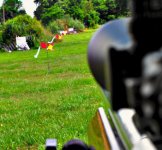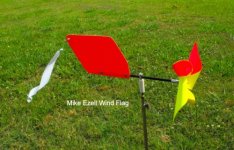mwezell
Mike Ezell
Well, we all like pics
After shooting over and testing just about every commercially available flags imaginable, I decided that there were pro's and con's to all of them. I like daisies for the potential info feedback...but not garden daisies. As Butch said, they tend to be slow to start and stop, as well as not doing a very good job at showing velocity or angles. Big angle changes are evident with the vanes, but the subtle ones are harder to see with most flags. A multi colored pinwheel or daisy works well here. Another thing about garden daisies is that they tend to get broken pretty often.
Also, while using bearings sounds like a good idea, in testing, they actually proved to slow a good flag down but are a big improvement over some of the designs out there. Bearings actually create friction area and increase drag over a well thought out flag design.
Coroplast, or plastic cardboard, is cheap and easy to work with, and is what most flags are made of. It works great for target backers but breaks down over time and takes on water when it rains on them. So, I wanted something better.
I decided to build and sell what I believe to be a better flag that is very sensitive, yet durable...and uses a daisy that shows angles and velocity. I went with an all fiberglass construction..even the daisy. I opted for teflon over bearings, derin or aluminum...etc. at the pivot points.
There's more to a good flag than good materials, such as size and proportion. It must be sensitive, stable and readable. Then come practicality issues, such as transport and assembly/disassembly.
This is what I came up with. If you click on this link http://s196.photobucket.com/user/mwezell/library/Neon%20Windflags?sort=3&page=1 it'll take you to an album with more pics. It is IMHO the best flag I've ever seen or tested. The Australian flags that Butch sells is also a very good flag. I have an ad in the classifieds on this site. --Mike Ezell www.ezellcustomrifles.com

After shooting over and testing just about every commercially available flags imaginable, I decided that there were pro's and con's to all of them. I like daisies for the potential info feedback...but not garden daisies. As Butch said, they tend to be slow to start and stop, as well as not doing a very good job at showing velocity or angles. Big angle changes are evident with the vanes, but the subtle ones are harder to see with most flags. A multi colored pinwheel or daisy works well here. Another thing about garden daisies is that they tend to get broken pretty often.
Also, while using bearings sounds like a good idea, in testing, they actually proved to slow a good flag down but are a big improvement over some of the designs out there. Bearings actually create friction area and increase drag over a well thought out flag design.
Coroplast, or plastic cardboard, is cheap and easy to work with, and is what most flags are made of. It works great for target backers but breaks down over time and takes on water when it rains on them. So, I wanted something better.
I decided to build and sell what I believe to be a better flag that is very sensitive, yet durable...and uses a daisy that shows angles and velocity. I went with an all fiberglass construction..even the daisy. I opted for teflon over bearings, derin or aluminum...etc. at the pivot points.
There's more to a good flag than good materials, such as size and proportion. It must be sensitive, stable and readable. Then come practicality issues, such as transport and assembly/disassembly.
This is what I came up with. If you click on this link http://s196.photobucket.com/user/mwezell/library/Neon%20Windflags?sort=3&page=1 it'll take you to an album with more pics. It is IMHO the best flag I've ever seen or tested. The Australian flags that Butch sells is also a very good flag. I have an ad in the classifieds on this site. --Mike Ezell www.ezellcustomrifles.com

Last edited:







